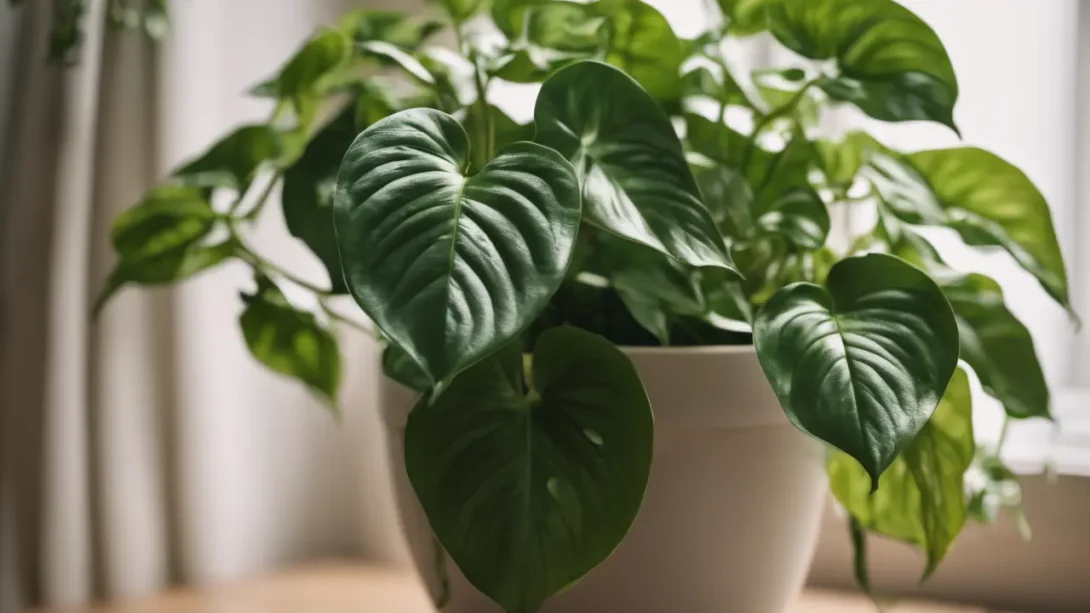Pothos (Epipremnum aureum), often celebrated for its lush, trailing vines and heart-shaped leaves, stands as a favorite among houseplant enthusiasts. Renowned not only for its aesthetic appeal but also for its forgiving nature, Pothos has a reputation for vigorous growth under a variety of conditions. This article explores the growth rate of Pothos and the factors that influence it, offering insight into how to nurture this resilient plant for optimal growth.
Pothos
Species Overview
Pothos, also known as Devil’s Ivy, is characterized by its glossy, heart-shaped leaves that come in a variety of patterns and colors, from deep green to variegated with yellow, white, or even light green. Native to the understorey of tropical forests, Pothos has adapted to thrive in low-light conditions, making it an ideal plant for indoor environments. Its ability to grow in water or soil adds to its versatility and popularity among gardeners.
Why Pothos is Popular
The appeal of Pothos lies in its ease of care, making it a suitable choice for both novice and experienced plant owners. Its trailing vines can beautify any space, serving as a striking hanging plant or a lush, green addition to shelves and tabletops. Beyond its decorative use, Pothos is lauded for its air-purifying qualities, capable of absorbing and neutralizing toxins in the home environment.
Factors Influencing Pothos Growth Rate
The growth rate of Pothos can vary significantly depending on several environmental factors. Understanding and optimizing these conditions can lead to healthier plants and more rapid growth.
Light
While Pothos is renowned for its tolerance to low light, its growth rate is considerably influenced by light intensity and exposure. Optimal growth is observed under bright, indirect light, where the plant can photosynthesize efficiently without the risk of leaf burn. Varieties with variegated leaves may require slightly more light to maintain their distinctive patterns.
Water
Watering practices play a critical role in the health and growth of Pothos. The plant prefers soil that is moist but well-drained, avoiding extremes of dryness or waterlogging. Overwatering can lead to root rot, while under-watering can stress the plant, both conditions resulting in slowed growth. Establishing a consistent watering routine, allowing the top inch of soil to dry out between waterings, supports steady growth.
Temperature and Humidity
Pothos thrives in a warm, humid environment, mirroring its tropical origins. Temperatures between 65°F to 85°F (18°C to 29°C) are ideal, with the plant capable of tolerating a wider range, albeit with potentially slower growth. Humidity levels around 50% to 70% encourage lush, healthy foliage; however, Pothos remains adaptable to less humid conditions commonly found in homes.
Soil and Fertilization
The choice of soil and the use of fertilizers are pivotal in promoting the robust growth of Pothos. A well-draining potting mix that retains moisture without becoming waterlogged provides an ideal environment for root development. Incorporating perlite or vermiculite can enhance drainage, ensuring the roots receive adequate oxygen and reducing the risk of root rot.
Fertilization serves as a crucial supplement to natural soil nutrients, particularly for indoor plants like Pothos that have limited access to the diverse nutrient sources available in outdoor environments. A balanced, water-soluble fertilizer applied every 4-6 weeks during the growing season (spring and summer) can significantly boost growth. It’s important to reduce fertilization frequency in fall and winter, when the plant’s growth naturally slows.
Pruning
Pruning is not just about maintaining the shape and size of your Pothos; it’s also a strategic tool for encouraging fuller, more vigorous growth. Regular pruning stimulates the plant to produce new branches, leading to a denser, lusher appearance. By cutting back leggy vines, you encourage the growth of new shoots closer to the base of the plant. Pruning is best done in the spring or early summer, coinciding with the plant’s natural growth spurt.
Average Growth Rate of Pothos
Understanding the average growth rate of Pothos helps set realistic expectations for your plant’s development. Under optimal conditions, Pothos can grow several inches each month, with vines extending up to 10 feet or more in length over time. However, growth rates can vary widely based on the factors previously discussed, with variegated varieties often growing more slowly than their solid green counterparts due to their reduced chlorophyll content.
Maximizing Pothos Growth
To achieve the fastest possible growth from your Pothos, providing an environment that closely mimics its natural habitat is key. This includes optimizing the balance of light, water, temperature, and humidity, as well as ensuring the plant has access to the nutrients it needs through proper soil composition and regular fertilization.
Optimizing Environmental Conditions
Bright, indirect light accelerates photosynthesis and promotes vigorous growth, so positioning your Pothos near a window with filtered sunlight is ideal. Monitor moisture levels in the soil to prevent over or under-watering, and consider using a humidifier or pebble tray to increase humidity if your home environment is dry. Regularly assessing and adjusting these conditions will support the health and growth of your Pothos.
Troubleshooting Slow Growth
If your Pothos is growing more slowly than expected, several factors could be at play. Insufficient light is a common culprit, as is overwatering or underwatering. Evaluate your plant care routine to identify any discrepancies from the ideal conditions outlined. Adjustments to lighting, watering frequency, or pot size (to prevent root-bound plants) can often resolve growth issues.
Propagation to Promote Growth
Propagation is not only a method to multiply your Pothos plants but also a way to rejuvenate and stimulate further growth in the parent plant. By taking cuttings from a mature plant, you encourage the development of new shoots at the site of the cut, leading to a fuller and more vibrant plant. Propagation can be done in water or soil, with each method offering its own set of benefits. Water propagation allows for easy observation of root development, while soil propagation can provide a more seamless transition for the new plant. Regardless of the method chosen, propagation is a rewarding process that can enhance the health and appearance of your Pothos.
Pothos Growth: Real-Life Examples
To illustrate the potential growth of Pothos, consider the following real-life examples. One gardener reported their Pothos growing over 5 feet in just one year, with the plant receiving bright, indirect light and regular waterings. Another example includes a Pothos grown in an office setting with artificial lighting, where the plant reached lengths of over 3 feet in a similar timeframe. These examples underscore the adaptability of Pothos and its capacity for impressive growth under varying conditions.
Conclusion
The growth rate of Pothos is influenced by a myriad of factors, including light, water, temperature, humidity, soil, and fertilization. By understanding and optimizing these conditions, you can maximize the growth potential of your Pothos, enjoying its lush foliage and air-purifying benefits. Remember, each Pothos plant is unique, and part of the joy of gardening is discovering what works best for your specific environment and care routine. Whether you’re a seasoned gardener or a novice plant parent, the Pothos offers a rewarding experience with its resilient nature and vigorous growth.



